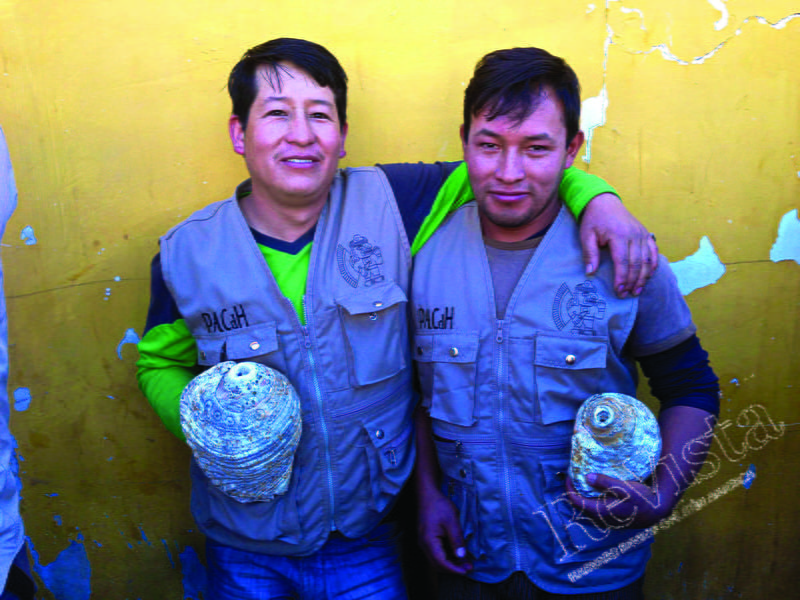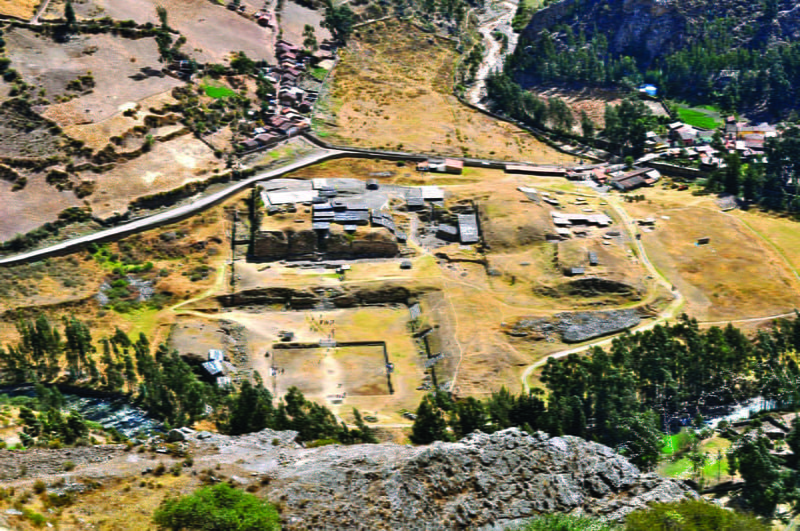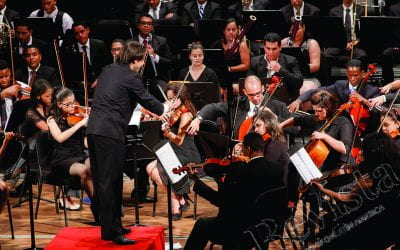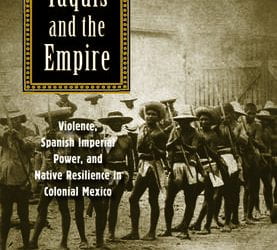El Pututu
The Sound of the Andes

Dressed in their official Proyecto Arqueológico Chavín de Huántar vests and holding their pututus, Rieman (left) and Aldo wait to begin their performance during the 28 de Julio parade. Photo by Sadie Weber
I first traveled to Peru in the summer of 2009 as an overly enthusiastic freshman on her first archaeological field school. My destination was Chavín de Huántar—a 3,000-year-old temple complex in the Sierra of Ancash. I learned about the site when my professor—John Rick of Stanford University—lectured about it during my introductory archaeology course. One day he brought out the pututu.
Pututu is a Quechua word meaning snail, but it has been coopted to refer to various trumpet-like instruments including those made of cow horns that appeared after the arrival of the Spanish. This particular pututu was a classically Andean conch trumpet made of the adult Strombus galeatus shell. I looked at it with relative indifference.
Then my professor played it. The melancholy drone filled the lecture hall and reverberated off the walls. We were all astonished to say the least; the sound had stunned all of us, and that was exactly Rick’s goal. Combining archaeology with sound was completely foreign to us, but an entirely appropriate lesson in the context of Chavín de Huántar.
The archaeological site comprises a monumental temple complex with a surrounding settlement that was occupied contemporaneously. The temple’s cut-and selected-stone architecture is honeycombed with a network of internal spaces known as galleries. These galleries—as well as the various plazas and platforms across the site—are thought to be the stage for the many rituals that occurred during the temple’s use.
In July 2001, a team of archaeologists, students and workers of the Proyecto Arqueológico Chavín de Huántar discovered a cache of pututus in a space that would become known as Galería de las Caracolas. Given the contents of other galleries, Rick conjectured that this space was used exclusively for the storage of these sacred objects. Marks of long-decayed textiles indicate that the pututus had been wrapped and stored with care. These instruments were prominent in Chavín iconography particularly in stone art, but this quantity of instruments had never been seen before; previous investigators had only encountered a few pututus or pieces of the shells themselves.
The embellishment of each instrument is highly varied. Some are elaborately incised with the complex, twisting iconography for which Chavín Period art is known, while others are comparatively plain. Each one is different—visually and acoustically. They are all still playable —we are able to produce the same sound a musician played 3,000 years ago. Each of the conch trumpets demonstrates its degree of use; these instruments were apparently used and valued for generations.
While we haven’t found another cache of this magnitude at Chavín de Huántar, we are understanding more and more the role these instruments played within the Chavín “cult.” The leaders of the cult convinced potential followers that their power and authority were real by bringing followers to the galleries and inducing hallucinations through the use of psychotropic plants and sensory deprivation or overstimulation. The drone of multiple instruments played simultaneously is thought to have amplified or focused the mental states of the Chavín cult intitiates.
Miriam Kolar, a postdoctoral fellow at Amherst College who was a graduate student in Stanford University’s Center for Computer Research in Music and Acoustics (CCRMA), studies the acoustic properties of these instruments in relation to the built space of the Chavín de Huántar temple. Studying the perception of sound in cultural contexts, Kolar has proved that the architecture of Chavín de Huántar was designed with the acoustic properties of the space and sound-making implements in mind.
FROM SNAIL TO SOUND
What becomes an instrument for us was once a live snail—the Eastern Pacific Giant Conch (Strombus or Lobatus galeatus). It is a large, herbivorous marine snail native, as their name suggests, to the warm tropical waters of the eastern Pacific Ocean and found as far north as Mexico and as far south as Ecuador. When Chavín de Huántar was growing as a monumental center, the 930-mile walk from Ecuador’s south coast to Chavín de Huántar would have taken at least twelve days to complete. This distance and effort involved augmented the status of pututus as a conspicuous prestige good.
Making a pututu is relatively simple. The end spine is cut off and the subsequent surface is polished to create a useable mouthpiece. The pututus from the cache are further modified with a v-shaped cut taken out of the apical lip. This cut is thought to have improved the musician’s ability to manipulate the tone of the instrument and improve visibility when playing the instrument during processions.
Producing a sound on a pututu, however, is not simple. While the mouthpiece appears similar to that of any brass instrument, the embouchure is distinct and challenging to master successfully. I have played various wind and brass instruments for most of my life, but my first attempt at pututu was a blow to my ego. My pitiful deflating balloon tone was nothing compared to the rich sound a musician can make. Since then I have improved, but I’m a novice when compared to the pros.
THE PUTUTU TODAY
My dissertation research is centered on Chavín de Huántar, where I have worked there since my first year of college. Since the gallery and cache discovery, the pututu has returned to the archaeological monument and town of Chavín de Huántar.
To mark the beginning of the excavations at Chavín de Huántar, we open each season with a pagapu or offering to the apus (mountain spirits) to ensure a safe excavation season. Eliseo—a lifetime resident of the town of Chavín de Huántar and a two-decade worker at the archaeological monument—begins the pagapu. He speaks of how honored he is to work in this sacred place and how fortunate we are to be afforded the opportunity to learn from those who came before us. The ceremony is trilingual, including speeches in Quechua, Spanish and English. Anyone who wants to speak is welcome. Following the speeches, coca, candy, rum and cigarettes are offered in the directions of the apus. The pagapu concludes with Eliseo’s son Reiman playing pututu to the apus and the earth. The sound the instrument produces is a haunting, deep noise that resonates through the valley and echoes off the Chavín de Huántar temple. And when the last note is played, the work begins again.
Archaeological project members also play the conch trumpets during the 28 de Julio (Independence Day) parade in the town of Chavín de Huántar. Rick and several site workers and technicians showcase their skills to the town and thousands of tourists that flock to the area to visit the monument. Each player produces a different tone on his pututu. The long drone is punctuated by another sound—a rasping, high pitched noise meant to mimic the voice of a jaguar—a powerful animal in the Andean religious pantheon.
The discovery of the gallery and cache afforded the residents of Chavín de Huántar a rare opportunity—the chance to revitalize the use and production of pututus in the Peruvian highlands as a specialized craft. Though undecorated instruments are common in the tourist craft markets of Lima and Cusco, the pututus produced in Chavín de Huántar are decorated using what are believed to be traditional production techniques.
Pututus are not limited to Chavín de Huántar, nor are they a lost instrument. While they did not entirely go out of use in the Andean region after the arrival of the Spanish, they have seen an increase in use in recent years. Pututus are consistently included at political events such as protests or inaugurations—most notably during the inauguration of Alejandro Toledo, the first indigenous president of Peru, and the third inauguration of Evo Morales, the first indigenous president of Bolivia.
I see the pututu as a symbol of the resilience and vigor of the Andes. Its persistent use in the political sphere is a testament to the influence of the past on the Andean present.
Winter 2016, Volume XV, Number 2
Sadie Weber is a fourth year Ph.D. candidate in anthropology at Harvard University. She is currently investigating the development and role of intensive llama and alpaca pastoralism in 1,200 BC Peru.
Related Articles
When Music Changes Lives
English + Español
n 2004, I got a surprising phone call from Santo Domingo on one cold winter night. I was then studying musical composition in Strasbourg, France, a great opportunity for a young Dominican…
The Politics of Gay Marriage in Latin America
Despite its recent successes, the gay rights movement in Latin America is generally ignored in discussions of contemporary Latin American politics. Even students of Latin American social…
The Yaquis and the Empire
Winner of the 2015 Latin American Studies Association Social Science Book Award and runner-up for the 2015 David J. Weber-Clements Prize of the Western History Association, The Yaquis…






